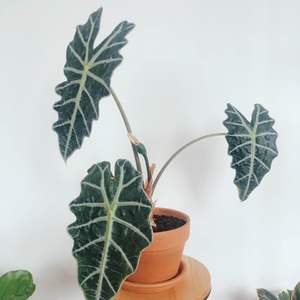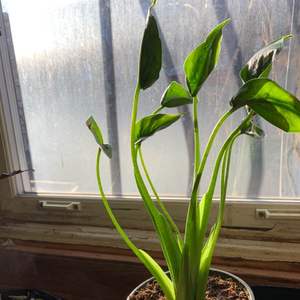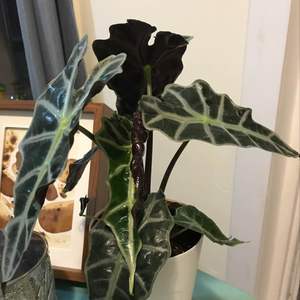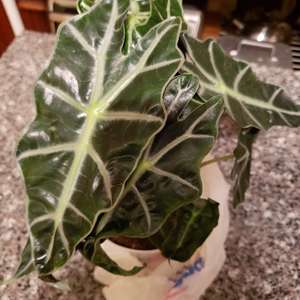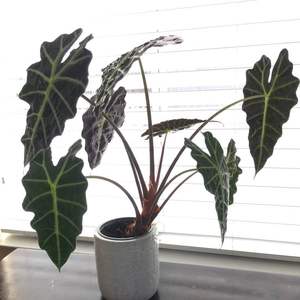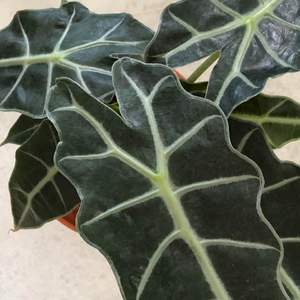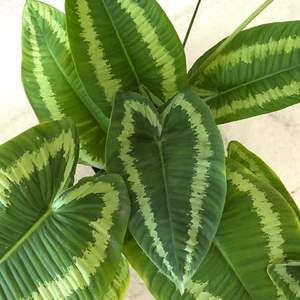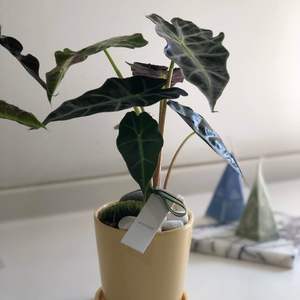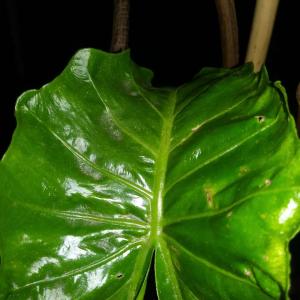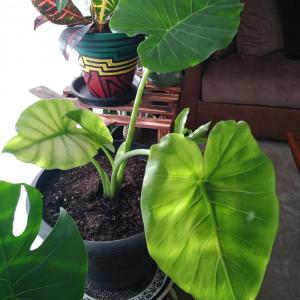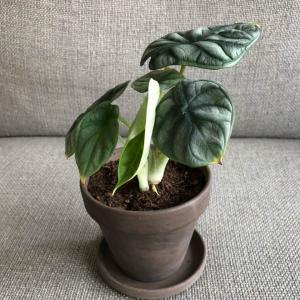文章
Miss Chen
2021年07月13日

Tropical plants in the Alocasia genus feature stunning foliage that can become the centerpiece of a garden or room. Large rhizomes or tubers produce enormous heart-shaped or arrow-shaped ears, leading to the popular common name, elephant's ear. They are most often grown as houseplants, but it's common to bring them outdoors during the warm months, sometimes burying the entire pot in the ground to create a natural look.
Alocasias can grow very fast, and in the right conditions, some species are considered invasive, especially along the gulf coast of the United States. Thus, verify with your local municipality before planting this species outdoors in the garden. If you have children or pets, you might want to avoid these plants altogether because the leaves are toxic to humans and animals.

FEATURED VIDEO
How to Grow and Care for Avocados as Houseplants
Botanical Name Alocasia
Common Name Alocasia, elephant ears, African mask
Plant Type Tropical plant grown as a houseplant in non-tropical climates
Mature Size 2–15 feet in height; 2–8 feet in spread (depends on species and variety)
Sun Exposure Bright indirect light indoors; part shade outdoors
Soil Type Loose, well-draining potting mix or crumbly loam
Soil pH 5.5 to 6.5 (slightly acidic)
Bloom Time Spring and summer
Flower Color Light butter-yellow (flowers are not showy)
Hardiness Zones 10–11 (often grown as a houseplant)
Native Areas Tropical and subtropical regions of Asia, eastern Australia
Toxicity Many species are highly toxic to humans and pets
Elephant's Ear Care
Even with a short growing season in northern climates, these plants can grow rapidly. In the warm summer months, Alocasia plants can produce a new leaf every week, and each new leaf can be twice the size of the previous week's. The leaf shapes can vary from slim arrowheads to wide heart-shaped leaves. have colorful veins and a variety of textures from thick, waxy, slick, and glossy.
Once the plant is in its dormant period (in the late fall and winter), it will begin resting. The rapid leaf growth will stop and the plant will likely remain as-is throughout the winter season. Continue to care for it, and the rapid growth will return the following growing season.
Light
Needs vary from shade to full sunlight, depending on the variety. Ask the grower or seller if the plant is sun-trained. Leaf color tends to be better among plants that grow best with more light.
Soil
Plant elephant's ear in loose, well-drained potting mix or crumbly loamy soil.
Water
Keep Alocasia plants moist all year; they are water-loving plants. There is a fine line with these plants. You want to keep the soil moist, but not soggy. They require less water during the winter months because the plant is dormant.
Allow the top few inches of soil to become nearly dry before watering. This will help keep the soil evenly moist. Soggy soil makes the plant susceptible to fungal infections.
Temperature and Humidity
Elephant ear plants will suffer below 60 degrees Fahrenheit. Some varieties will die back during colder weather and re-sprout from the rhizome. They require, and thrive in, very humid environments. To raise the humidity around your plant, place it on a tray filled with pebbles and then add water until it rises to just below the bottom of the pot. Keep them away from cold drafts from windows, doors, and air conditioning.
Fertilizer
Alocasias can be heavy feeders, especially large specimens. Feed with liquid fertilizer during the growing season or frequent, small applications of granule fertilizer.
Is Elephant Ear Toxic?
Alocasia is a very poisonous plant; the leaves contain insoluble oxalate crystals. A human or pet chewing or biting into a leaf releases the crystals which can cause swelling and irritation of the mouth and GI tract. Very rarely, extreme swelling of the upper airway can occur making it difficult to breathe. Keep the plant away from children and pets and call poison control, your doctor, or veterinarian if a person or animal ingests a plant leaf.
Elephant Ear Varieties
There are about 70 species of Alocasia, as well as dozens of hybrids. Alocasia plants are primarily hybridized because of the appeal of their leaf form, color, and size. Consider these varieties:
Alocasia sanderiana, also known as the Kris plant, has extremely dark green foliage and provides an exotic-looking houseplant. Its long, pointed leaves have white veins and scalloped edges outlined in white.
Alocasia x amazonica is a hybrid that features leathery, wavy-edged, arrowhead-shaped, dark bronze-green leaves (up to 16 inches long)
Alocasia macrorrhizos, also known as giant taro, is a truly enormous plant that can grow up to 15 feet tall and 8 feet wide with leaves that can reach 3 to 4 feet long and 2 to 4 feet wide.
Additionally, the plant has been extensively hybridized. Most Alocasia species will survive in shade, but they often appreciate slightly brighter filtered sunlight. The bigger varieties can be trained to handle the full tropical sun. Keep all species warm, moist, and humid. Trim away faded leaves. Like all aroids, Alocasias flower with a typical spathe and spadix, but the flower is usually unremarkable.

Potting and Repotting
Repot Alocasia varieties annually into larger pots with fresh, free-draining potting soil. Also, it's best to divide the rhizome annually to keep the plant a manageable size and increase your collection.
Propagating Alocasia
Most Alocasia plants can be propagated by clump or rhizome division. Cut off a piece of the underground rhizome and pot it up separately. Keep it warm and moist until new growth begins.
Common Pests/Diseases
While quite striking, these plants can be quite sensitive to a variety of diseases including crown, stem, and root rot, leaf spot, and Xanthomonas infection. Signs of diseases are typically black or dark brown spots on the leaves and a yellowish rim around the spots. You can prevent disease with proper watering practices; do not overwater these plants. Keep the foliage dry and provide proper air circulation around and near the plant.
Common pests of Alocasia include mealybugs, scale, aphids, and spider mites. Every few weeks, spray the plant with warm soapy water to prevent these pests and keep the plant dust-free. If an infestation occurs, use an ultra-fine insecticide oil or neem oil. These products will kill the pests and their eggs.
Alocasias can grow very fast, and in the right conditions, some species are considered invasive, especially along the gulf coast of the United States. Thus, verify with your local municipality before planting this species outdoors in the garden. If you have children or pets, you might want to avoid these plants altogether because the leaves are toxic to humans and animals.

FEATURED VIDEO
How to Grow and Care for Avocados as Houseplants
Botanical Name Alocasia
Common Name Alocasia, elephant ears, African mask
Plant Type Tropical plant grown as a houseplant in non-tropical climates
Mature Size 2–15 feet in height; 2–8 feet in spread (depends on species and variety)
Sun Exposure Bright indirect light indoors; part shade outdoors
Soil Type Loose, well-draining potting mix or crumbly loam
Soil pH 5.5 to 6.5 (slightly acidic)
Bloom Time Spring and summer
Flower Color Light butter-yellow (flowers are not showy)
Hardiness Zones 10–11 (often grown as a houseplant)
Native Areas Tropical and subtropical regions of Asia, eastern Australia
Toxicity Many species are highly toxic to humans and pets
Elephant's Ear Care
Even with a short growing season in northern climates, these plants can grow rapidly. In the warm summer months, Alocasia plants can produce a new leaf every week, and each new leaf can be twice the size of the previous week's. The leaf shapes can vary from slim arrowheads to wide heart-shaped leaves. have colorful veins and a variety of textures from thick, waxy, slick, and glossy.
Once the plant is in its dormant period (in the late fall and winter), it will begin resting. The rapid leaf growth will stop and the plant will likely remain as-is throughout the winter season. Continue to care for it, and the rapid growth will return the following growing season.
Light
Needs vary from shade to full sunlight, depending on the variety. Ask the grower or seller if the plant is sun-trained. Leaf color tends to be better among plants that grow best with more light.
Soil
Plant elephant's ear in loose, well-drained potting mix or crumbly loamy soil.
Water
Keep Alocasia plants moist all year; they are water-loving plants. There is a fine line with these plants. You want to keep the soil moist, but not soggy. They require less water during the winter months because the plant is dormant.
Allow the top few inches of soil to become nearly dry before watering. This will help keep the soil evenly moist. Soggy soil makes the plant susceptible to fungal infections.
Temperature and Humidity
Elephant ear plants will suffer below 60 degrees Fahrenheit. Some varieties will die back during colder weather and re-sprout from the rhizome. They require, and thrive in, very humid environments. To raise the humidity around your plant, place it on a tray filled with pebbles and then add water until it rises to just below the bottom of the pot. Keep them away from cold drafts from windows, doors, and air conditioning.
Fertilizer
Alocasias can be heavy feeders, especially large specimens. Feed with liquid fertilizer during the growing season or frequent, small applications of granule fertilizer.
Is Elephant Ear Toxic?
Alocasia is a very poisonous plant; the leaves contain insoluble oxalate crystals. A human or pet chewing or biting into a leaf releases the crystals which can cause swelling and irritation of the mouth and GI tract. Very rarely, extreme swelling of the upper airway can occur making it difficult to breathe. Keep the plant away from children and pets and call poison control, your doctor, or veterinarian if a person or animal ingests a plant leaf.
Elephant Ear Varieties
There are about 70 species of Alocasia, as well as dozens of hybrids. Alocasia plants are primarily hybridized because of the appeal of their leaf form, color, and size. Consider these varieties:
Alocasia sanderiana, also known as the Kris plant, has extremely dark green foliage and provides an exotic-looking houseplant. Its long, pointed leaves have white veins and scalloped edges outlined in white.
Alocasia x amazonica is a hybrid that features leathery, wavy-edged, arrowhead-shaped, dark bronze-green leaves (up to 16 inches long)
Alocasia macrorrhizos, also known as giant taro, is a truly enormous plant that can grow up to 15 feet tall and 8 feet wide with leaves that can reach 3 to 4 feet long and 2 to 4 feet wide.
Additionally, the plant has been extensively hybridized. Most Alocasia species will survive in shade, but they often appreciate slightly brighter filtered sunlight. The bigger varieties can be trained to handle the full tropical sun. Keep all species warm, moist, and humid. Trim away faded leaves. Like all aroids, Alocasias flower with a typical spathe and spadix, but the flower is usually unremarkable.

Potting and Repotting
Repot Alocasia varieties annually into larger pots with fresh, free-draining potting soil. Also, it's best to divide the rhizome annually to keep the plant a manageable size and increase your collection.
Propagating Alocasia
Most Alocasia plants can be propagated by clump or rhizome division. Cut off a piece of the underground rhizome and pot it up separately. Keep it warm and moist until new growth begins.
Common Pests/Diseases
While quite striking, these plants can be quite sensitive to a variety of diseases including crown, stem, and root rot, leaf spot, and Xanthomonas infection. Signs of diseases are typically black or dark brown spots on the leaves and a yellowish rim around the spots. You can prevent disease with proper watering practices; do not overwater these plants. Keep the foliage dry and provide proper air circulation around and near the plant.
Common pests of Alocasia include mealybugs, scale, aphids, and spider mites. Every few weeks, spray the plant with warm soapy water to prevent these pests and keep the plant dust-free. If an infestation occurs, use an ultra-fine insecticide oil or neem oil. These products will kill the pests and their eggs.
0
0



